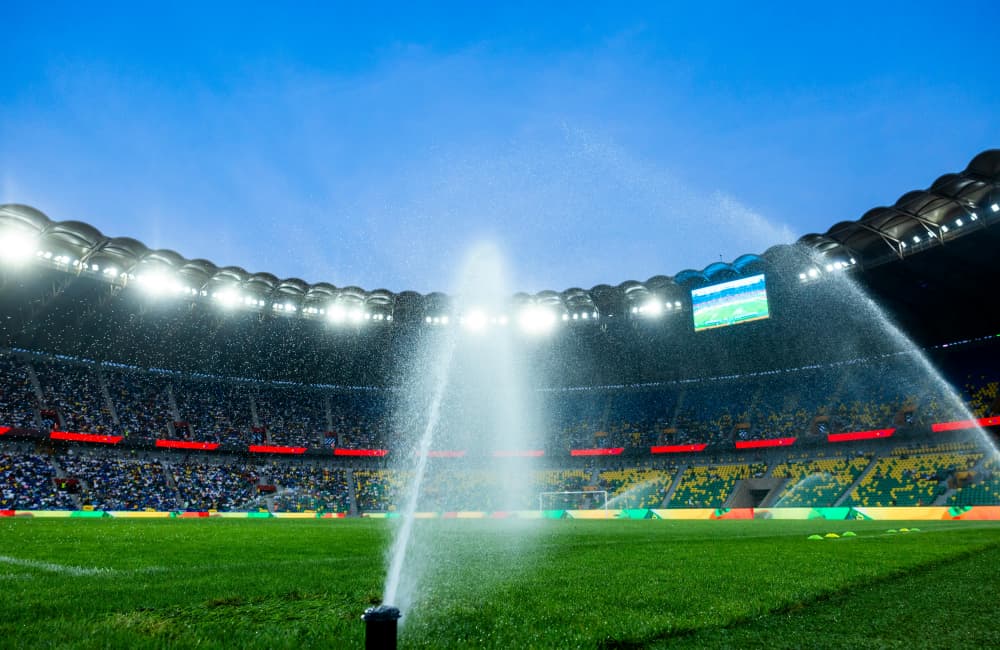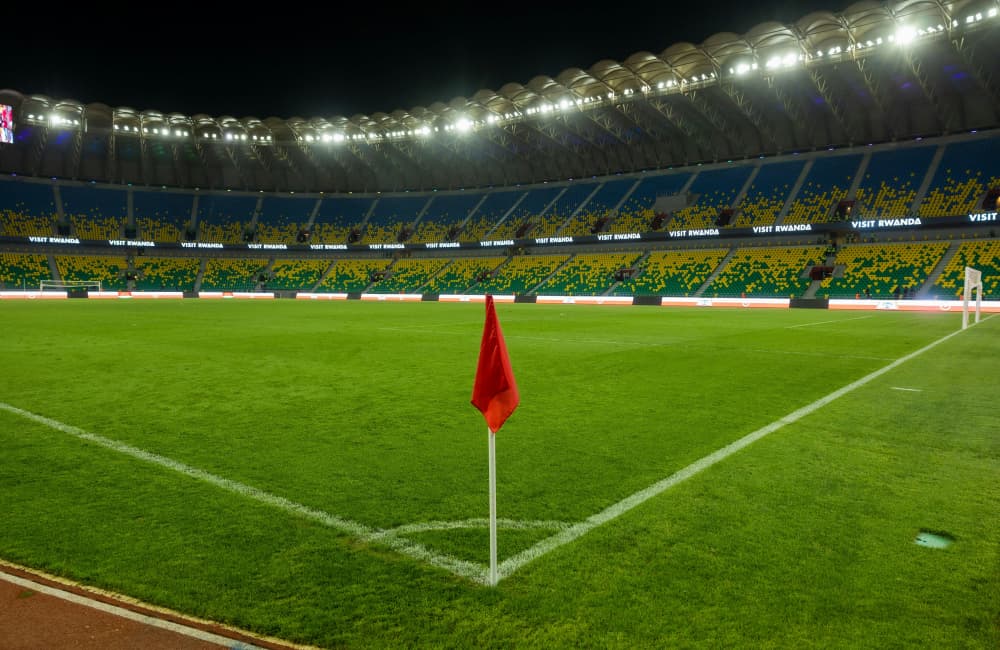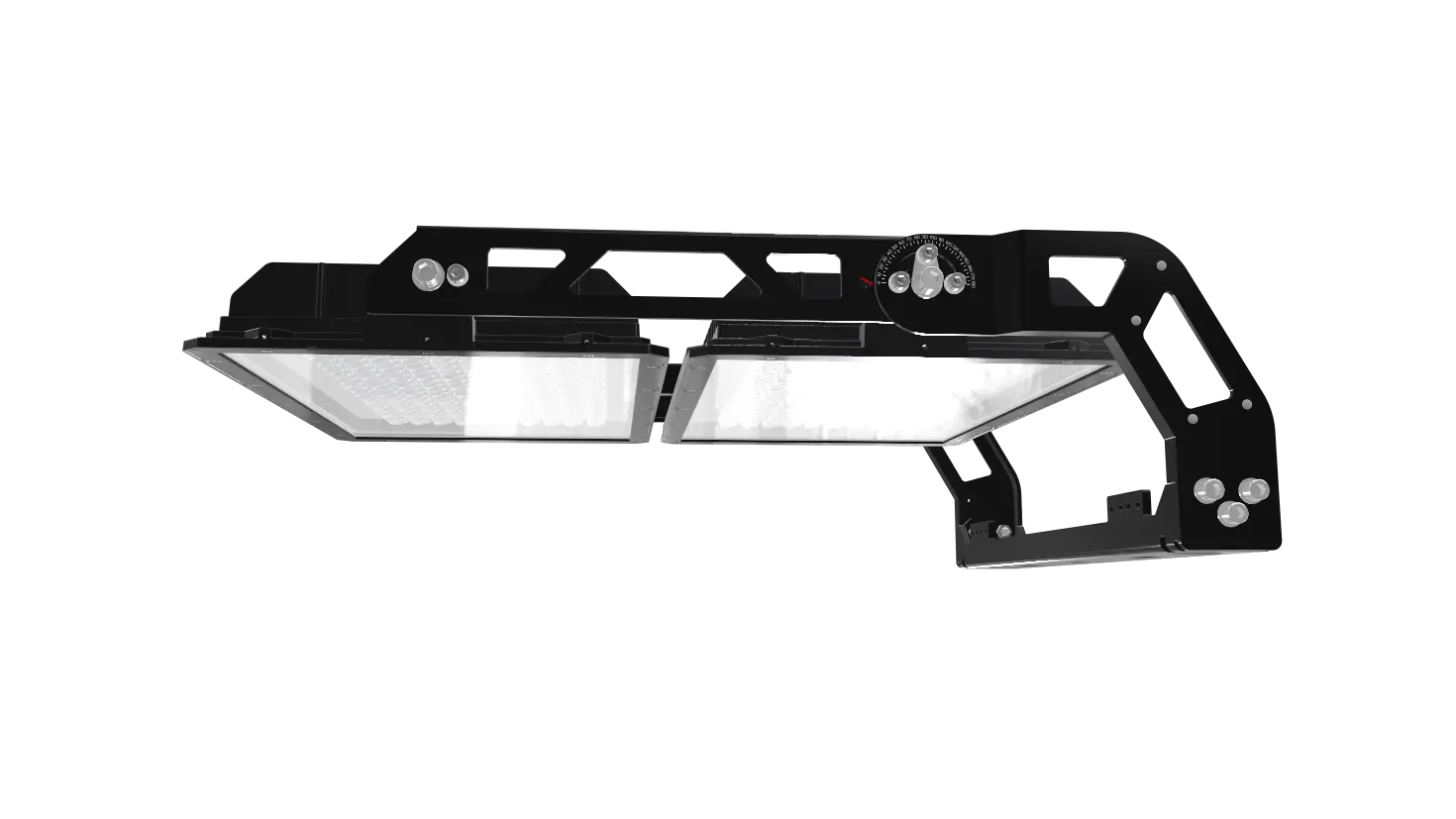足球场灯光指南:LED照明设计与成本
照明可以成就一场足球比赛,也可以毁掉一场足球比赛。从社区足球场到国家体育场,足球场灯光是决定可见度、安全性乃至球员表现的关键。然而,许多设施管理人员仍在苦苦挣扎于过时的照明方案——维护成本高昂,而且亮度不均匀。
如果您正在升级或设计球场,本指南将帮助您了解如何选择和设计符合专业标准、节省高达 70% 的能源并为球员和观众提供完美可视度的 LED 足球场照明。

目录:
1.什么是足球场灯?
照明是每场夜间足球比赛的支柱。如果没有适当的照明,即使是最好的体育场也会失去其魅力。足球场灯(也称为体育场灯或运动泛光灯)是一种强大的户外灯具,旨在均匀覆盖大片比赛区域,确保球员、裁判和观众清晰地看到每一个动作。
1.1 定义与核心功能
简单来说,足球场灯是高强度 LED 泛光灯,旨在为整个球场提供均匀的亮度。
它们有三个基本用途:
① 可见性:使球员和球迷能够关注快节奏的动作。
② 安全性:消除暗点和眩光,防止事故发生。
③ 广播质量:确保摄像机捕捉到清晰、色彩准确的画面,用于电视或在线流媒体播放。
一个典型的全尺寸足球场需要六到八根灯杆,每根灯杆都装有多个灯具,以特定的光束角度投射光线,以避免眩光和阴影重叠。

1.2足球场灯的构造
专业 LED 足球场灯包括:
a. LED 模块:提供明亮、定向的光输出。
b. 光学透镜:控制光束角度(通常为 15°–60°)以实现有针对性的覆盖。
c. 散热器:保持温度稳定,延长LED寿命。
d. 驱动器和电涌保护:在电压波动下保持一致的性能。
e. 外壳:铝或不锈钢外壳,防水等级为 IP66+,可防雨、防尘、防腐蚀。
每个组件都有助于实现稳定、无闪烁的照明——这是高清广播和慢动作重播的必备条件。
Now that we've covered what football field lights are, let's explore the lighting requirements and standards every field should meet to ensure professional-quality visibility.
2. What Are the Lighting Requirements for Football Field?
Lighting a football field isn't just about brightness — it's about balance, clarity, and consistency. A well-lit field lets players react faster, fans see clearly, and cameras capture every goal in detail.
So, before choosing LED football field lights, it's worth understanding the basic requirements that guide every professional design.
2.1 The Core Metrics That Define Good Football Lighting
A. Illuminance (Lux Levels)
Football fields are typically designed with an average horizontal illuminance between 300–2500 lux, depending on use:
Training or school fields: 300–500 lux
Amateur competition: 500–800 lux
Professional matches: 800–1500 lux
Televised events: 1500–2500 lux
Higher lux ensures better visibility of fast-moving balls and players, especially under HD broadcasting.
B. Uniformity (U1/U2 Ratio)
Uniform lighting avoids bright or dark spots across the pitch.
Target uniformity: ≥0.6 (U1) and ≥0.7 (U2).
When light is evenly distributed, players' eyes adjust naturally and visual fatigue decreases.
C. Color Temperature (CCT)
Most football fields use 5000–6000K, a daylight-like white that enhances color contrast and realism on camera.
D. Color Rendering Index (CRI)
A CRI ≥80 is recommended. This ensures jerseys, turf, and ball colors look true to life under LED light — an important factor for spectators and broadcasters alike.
2.2 Standards You Can Refer To
Different organizations set clear standards for sports lighting performance.
The most recognized are:
l FIFA (Fédération Internationale de Football Association) – for professional football stadiums.
l CIE (International Commission on Illumination) – defines lighting quality principles for all sports.
l IES (Illuminating Engineering Society) – commonly used in the U.S. for design reference.
According to FIFA's Football Stadium Lighting Guide and CIE 121:2018, fields are categorized into three classes:
Class | Application | Average Horizontal Illuminance (lux) | Uniformity (Emin / Eavg) | Color Rendering (CRI) |
Class III | Training / Recreational | 200–300 lx | ≥ 0.5 | ≥ 70 |
Class II | Amateur / Semi-professional matches | 500–750 lx | ≥ 0.6 | ≥ 80 |
Class I | Professional competition / TV broadcasting | 1000–2000 lx | ≥ 0.7 | ≥ 80–90 |
3. How to Light a Football Field: Design & Layout Basics
Designing football field lighting isn't just about picking bright fixtures — it's about precision.
A field that looks great on paper may fail in real play if the lights are uneven, glaring, or poorly aimed.
This chapter walks you through the essential design and layout principles for football field lighting, helping you plan a system that performs consistently for years.

3.1 Start With the Right Lighting Goal
Before you begin designing, define your goal. Lighting requirements change depending on how the field will be used:
Quick Tip: Higher-level competitions not only need more brightness but also better uniformity and color rendering for both visibility and TV broadcast.
3.2 Pole Layout: Even Light Starts With Smart Positioning
Pole placement directly impacts uniformity and glare control.
A well-designed system ensures every corner of the pitch is evenly lit.
Common layouts:
4-pole layout: Suitable for training grounds or small community fields. Two poles per sideline.
6-pole layout: The most cost-effective for amateur matches — 3 poles on each long side.
8-pole layout: Standard for professional football fields. Allows better light distribution and reduces shadows near the goals.
Hybrid layout (6+2 corner poles): Used for televised stadiums that require high vertical illumination for camera angles.
Key parameters:
Pole height: 18–30 m depending on field size and lighting level.
Distance from sideline: 5–10 m away to minimize glare and ensure beam spread.
Tilt angle: 20–30° is ideal for achieving balanced vertical and horizontal illuminance.
3.3 Beam Angle and Optics: Direct the Light, Don’t Waste It
The goal is to light the players, not the sky. Choosing the right optics and aiming angles helps achieve this efficiently.
Narrow beams (10°–30°): Ideal for long-throw applications or high poles.
Medium beams (30°–60°): Best for mid-field illumination.
Wide beams (60°–90°): Used near sidelines or corners to fill gaps.
Ceramiclite's LED football field lights use precision beam control lenses that achieve ±3° aiming accuracy, ensuring maximum light hits the target area and reducing spill light by up to 30%.
3.4 Balancing Horizontal and Vertical Illuminance
Many first-time planners only focus on ground brightness (horizontal lux). However, vertical illuminance — the light on players' faces and bodies — is equally critical for spectators and camera views.
Horizontal illuminance: ensures the field is evenly bright for play.
Vertical illuminance: ensures faces and movements are visible from multiple camera angles.
A good football lighting design aims for vertical illuminance ≥70% of the horizontal level for professional fields.
3.5 Glare Control and Light Pollution Reduction
Too much brightness can cause more harm than good. Glare affects both players and neighbors around the stadium.
To minimize it:
Use anti-glare visors or asymmetric optics.
Keep pole height adequate — higher poles = lower glare angles.
Adjust aiming angles using simulation software before installation.
Comply with CIE 150:2017 light pollution guidelines.
Ceramiclite's sports lighting series adopts low-glare design optics and shielded modules, ensuring compliance with FIFA and EN standards while keeping the night sky dark-friendly.
3.6 Simplify the Process With Lighting Design Software
Modern lighting design relies on simulation tools like Dialux or Relux, which calculate lux distribution, glare (GR), and uniformity before installation.
A quick simulation helps you:
(1) Test different pole layouts and angles
(2) Predict lighting results
(3) Optimize for cost vs. performance
Ceramiclite's engineering team provides free lighting design support — simply share your field dimensions and lighting goals, and they'll deliver a complete photometric layout plan within 48 hours.
In summary:
Effective football field lighting design is a balance between science and precision. It requires understanding how each fixture, beam angle, and pole position affects the total illumination pattern.
With a thoughtful layout and the right LED fixtures, you'll achieve perfect visibility, lower power costs, and long-lasting performance — all essential for modern stadiums and sports facilities.
4. How to Choose the Right LED Football Field Lighting?
Selecting the right LED football field lighting isn't just about brightness—it's about precision, performance, and long-term reliability. A well-chosen lighting system ensures players, referees, and spectators all experience the game clearly and safely. Here's what to focus on:
4.1 Match the Lighting Level to the Field’s Usage
Different football fields require different illumination levels.
Recreational fields: 200–300 lux is usually enough.
Training or community matches: Around 500 lux provides balanced visibility.
Professional stadiums or TV broadcast fields: 800–1200 lux ensures clear, flicker-free visuals for cameras.
Before purchasing, identify your field’s purpose—this determines how powerful your lights need to be.
4.2 Prioritize High Efficiency and Low Glare
Modern LED lights deliver more lumens per watt than traditional metal halide fixtures. Look for:
High efficacy (≥150 lm/W) for energy savings.
Anti-glare optical lenses or asymmetric beam designs to protect players' vision.
Uniform light distribution (U₀ ≥ 0.6) to avoid dark patches.
Efficient optics and glare control help balance brightness with comfort.
4.3 Check Color Rendering and Temperature
For sports lighting, color accuracy matters.
CRI ≥ 80 allows players and referees to distinguish uniforms and the ball clearly.
Color temperature 5000–5700K provides crisp daylight-like illumination that enhances visual clarity.
If the field is used for TV broadcasting, always confirm that the LEDs support flicker-free performance at high frame rates.
4.4 Consider Beam Angles and Mounting Heights
Light design depends on pole height and beam spread:
Wide beams (60–90°): For lower poles and small training fields.
Narrow beams (20–40°): For tall poles and large stadiums.
The right combination ensures the light reaches the field evenly without wasting output in the sky or stands.
4.5 Choose Durable, Weatherproof Fixtures
Outdoor football fields face harsh weather—your lights should handle it.
IP66 or higher for full protection against rain and dust.
IK08 or higher for impact resistance.
Die-cast aluminum housing and anti-corrosion coating extend service life.
Durability is especially important for coastal or humid regions where corrosion is common.
4.6 Ensure Smart Control & Easy Maintenance
Modern LED systems support smart control options, such as:
Dimming by schedule or match type
Group or zone control via mobile app or computer
Remote fault monitoring
These functions reduce energy consumption and simplify daily operations—especially for municipal or school-managed fields.
5. How Much Do Football Field Lights Cost?
The total cost of football field lights depends on several factors—field size, lighting level, number of poles, and fixture type. Whether you're upgrading to LED or building a new field, understanding the cost breakdown helps you plan your budget more effectively.
5.1 Average Cost Overview
Here's a quick look at typical LED football field lighting costs:
Field Type | Illumination Level | Approx. Cost (USD) |
Training / School Field | 200–500 lux | $25,000 – $60,000 |
Amateur Competition Field | 500–800 lux | $60,000 – $120,000 |
Professional Stadium | 800–1200 lux | $150,000 – $300,000+ |
These estimates include fixtures, poles, and installation but can vary by region and project complexity.
5.2 Key Factors That Influence the Price
A. Field Size & Pole Quantity
A standard 11-player football field (105m × 68m) typically uses 4–8 lighting poles, each fitted with 8–12 high-power fixtures.
Smaller 5-a-side or training fields need fewer poles and lights, reducing both material and installation costs.
B. Lighting Level (Lux Requirement)
The higher the required brightness, the more fixtures and wattage needed. For instance, a 200-lux recreational field may only need 20–25 fixtures, while a 1000-lux broadcast stadium could require 80+ fixtures.
C. LED Wattage and Quality
High-end LEDs (150–160 lm/W) can achieve the same brightness with fewer units.
Cheap, low-efficiency lights may seem affordable but increase both energy and maintenance costs over time.
D. Mounting Height & Structure
Taller poles (25–35 m) require stronger bases, cable management, and windproof design—adding to the installation cost.
E. Control System & Accessories
Optional smart systems, surge protection, and DMX dimming functions slightly increase upfront investment but improve long-term flexibility and savings.
5.3 Running and Maintenance Costs
One major advantage of LED football field lighting is its lower operating cost.
Energy savings: Up to 70% lower electricity consumption compared to metal halide lights.
Maintenance: LEDs last 50,000–100,000 hours, reducing the need for bulb replacements and lift rentals.
Instant on/off: No warm-up time or flicker—saving time and energy during events.
Over 10 years, switching to LED can save tens of thousands of dollars in power and maintenance costs.
5.4 Example Cost Comparison: Metal Halide vs. LED
Item | Metal Halide | LED |
Average Lifespan | 6,000–10,000 hrs | 50,000–100,000 hrs |
Energy Efficiency | 80–100 lm/W | 150–160 lm/W |
Warm-up Time | 10–15 min | Instant |
Maintenance Frequency | High | Very low |
Long-Term Cost | High | Low |
LED systems have a higher upfront cost but a significantly lower total cost of ownership (TCO), making them the best long-term investment for football fields.
6. Conclusion: Brighten the Game with Ceramiclite
Lighting defines how every match feels—whether it's a local school game under soft evening skies or a professional tournament broadcast to millions. The right LED football field lights don't just illuminate the pitch; they elevate the entire experience for players and fans alike.
Choosing LED over traditional metal halide systems means better visibility, lower costs, and less hassle. You get consistent brightness, no flicker, instant start-up, and up to 70% energy savings. With proper design—balanced uniformity, ideal color temperature, and glare control—you ensure every pass, every goal, and every moment shines clearly.
If you're planning to upgrade your football field lighting, now is the time to move to LED.
Contact Ceramiclite today to get a free lighting plan and quote—because the game deserves to be seen at its best.
7. FAQs
Q1: What are the lights on a football field called?
They’re commonly known as stadium lights or sports field floodlights. In modern installations, they are usually LED football field lights, offering better brightness, efficiency, and color accuracy than traditional metal halide lamps.
Q2: How many lumens do you need to light a football field?
It depends on the level of play:
Training or school fields: around 200,000–400,000 lumens total
Amateur matches: 500,000–700,000 lumens
Professional stadiums: can exceed 1,000,000 lumens
More important than raw brightness is uniformity—even light across the pitch prevents dark spots and glare.
Q3: How much do football field lights cost to install?
Costs vary based on pole height, wattage, and control systems.
Small fields (training/recreation): $20,000–$50,000
High school or semi-pro stadiums: $60,000–$120,000
Professional venues: $150,000+
LED systems cost more upfront but save up to 70% on energy and maintenance over time.
Q4: How long do LED football field lights last?
A high-quality LED fixture from brands like Ceramiclite can last 50,000–100,000 hours, or roughly 10–20 years depending on usage. Unlike metal halide lamps, LEDs maintain over 80% brightness even after years of operation.
Q5: Can football field lights be dimmed or controlled remotely?
是的。Ceramiclite 的系统支持智能照明控制,您可以通过简单的界面或应用程序调暗、安排或监控每个区域。这有助于在训练期间或部分场地使用时节省能源。
Q6:足球场照明的理想色温是多少?
5000K 至 5700K 之间,提供清晰、如日光般的可视度。它增强了球员和转播摄像机的色彩对比度。
Q7:我如何获得足球场照明设计或报价?
联系 Ceramiclite 获取免费的光度照明方案和成本估算。我们的专家将帮助您选择合适的 LED 系统、灯杆布局和光学器件,以满足 FIFA、CIE 或当地体育标准。
_thumb.jpg)

